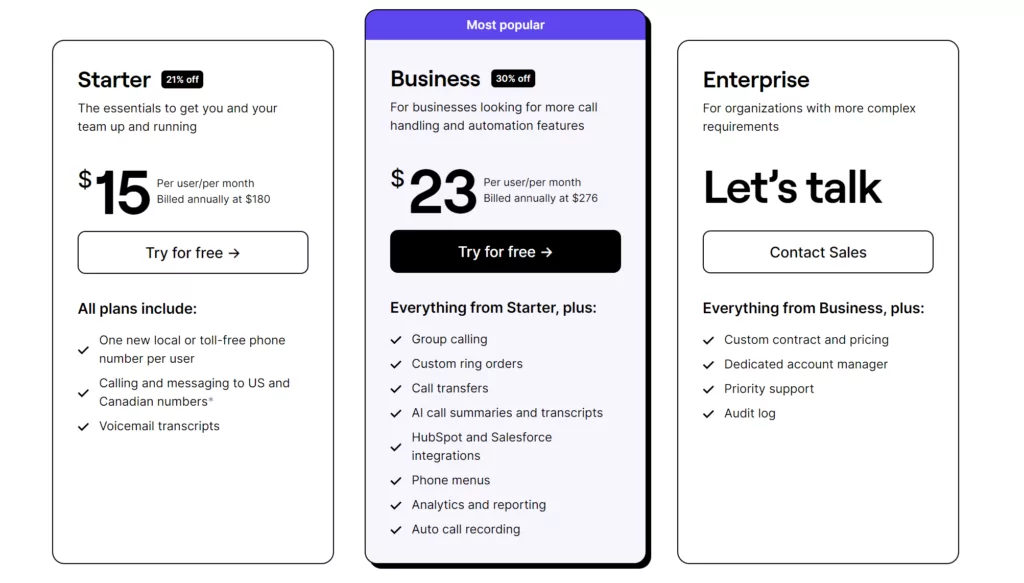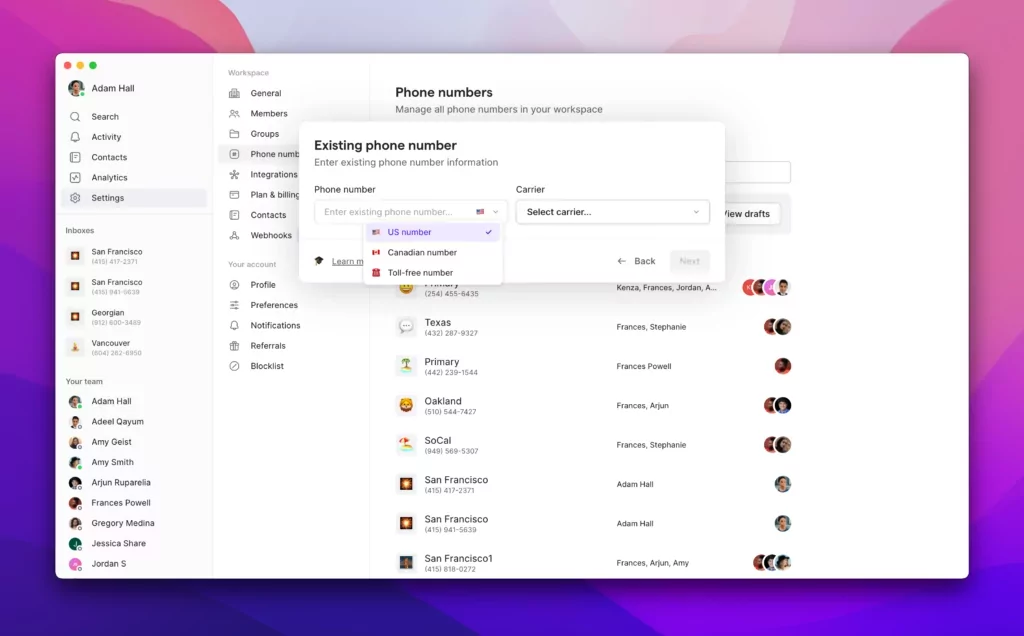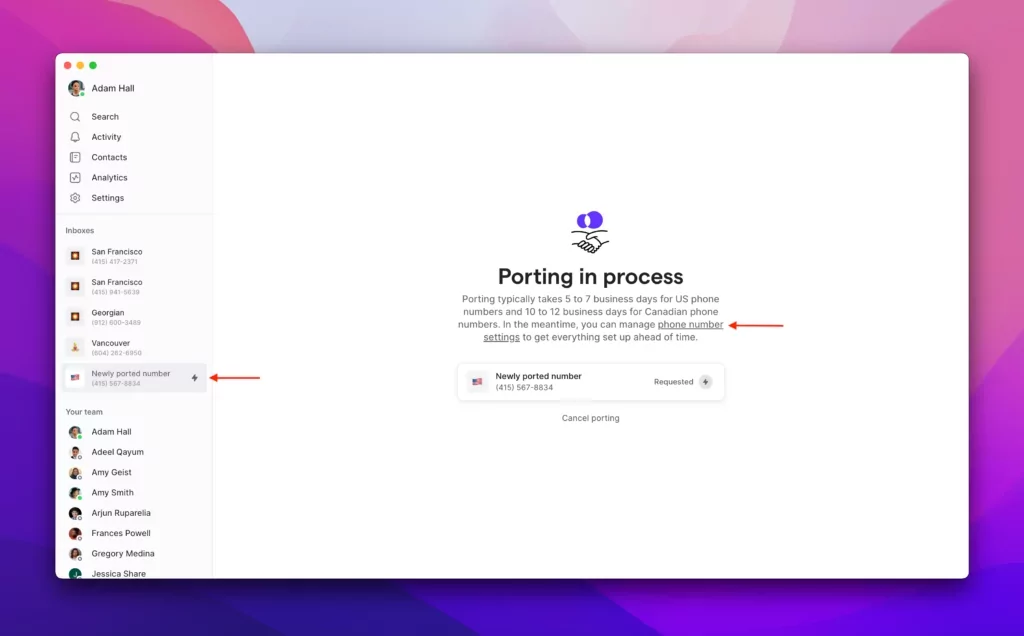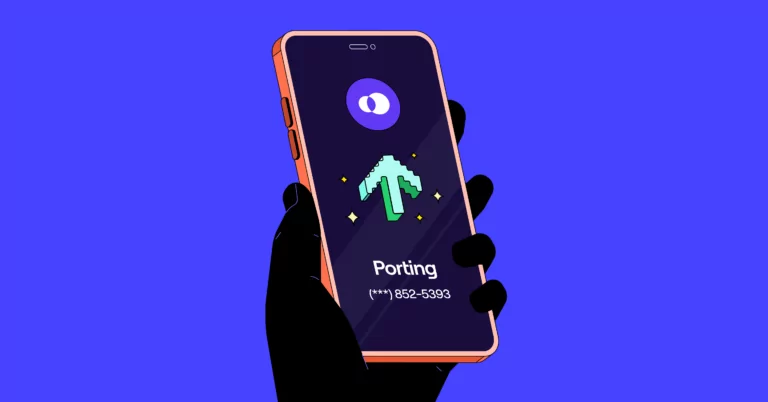So how long does it take to port a number? Unlike porting a mobile number to another cell phone carrier, transferring your VolP phone number to a new provider is not an instantaneous process. In order to properly follow all telecom laws, the entire transfer can take as long as two to four weeks.
How long does it take to port a number?
The average time it takes to port an existing number to a VoIP provider is 5-7 business days for US numbers and 7-10 business days for Canadian numbers. 🗓️ However, the exact duration can vary depending on several factors such as the responsiveness of your current provider and the accuracy of the information provided.
Don’t worry, though. Your phone number should still be accessible to use with your current provider up until the date your number ports over.
The answer to “how long does it take to port a number?” ultimately depends on variety of factors including your existing provider, new provider, your cell phone, and any documentation that applies to your number. This article will help you gauge the time necessary to port your number to a new provider based on nine factors that can impact the porting time.
Why does porting a number take so long?
For one, carriers deliberately designed the process to be difficult and time-consuming because they don’t want customers to leave. They hope the frustration of following a lengthy process will discourage you from switching carriers.
Secondly, carriers created the porting rules. These rules mandate that specific documents need to be signed and consistent with existing records, and that carriers have 30 days to comply with each request. That means carriers can wait until the end of the 30 days, mark documents as inconsistent or incorrect, and start the process again. Though the FCC stepped in to try to crack down to this subtle drawing out of the timeline, the 30-day window still exists.
Finally, coordinating between old and new service providers is often tedious since companies have different internal processes and timelines for handling port requests.
Here’s the average time different carriers need to successfully port a number:
| Service provider | Estimated time to port a number |
|---|---|
| OpenPhone | US numbers: 5 to 7 business days Canadian numbers: 10 to 12 business days |
| Verizon | Mobile: 4 to 24 hours Landline: 2 to 4 business days |
| AT&T | Mobile: Minutes to 5 business days Landline: 5 to 7 business days |
| T-Mobile | Mobile: 10 minutes to 2 hours Landline: 3 to 10 days |
| Google Voice | Up to 48 hours |
| Vonage | Up to 10 business days |
| RingCentral | 15 to 30 business days |
| Grasshopper | Up to 2 weeks |
9 factors that can impact how long it takes to port your number
From documentation accuracy to complex number transfers, these nine factors influence the porting process timeframe.
1. Incorrect or missing documentation
Missing documentation is one of the biggest reasons for port delays. The transfer process has several required documents that must be filled out prior to the number transfer. Due to FCC mandates, it’s important to get these documents to your provider ASAP.
Have you received a confirmation email for your port request? Check to see if your providers sent any initial documentation. If not, there may be another error holding up the transfer process.
Some common types of incorrect or missing documentation include:
- No LOA (Letter of Authorization) provided
- LOA provided but not signed
- No billing receipt provided
- Wrong billing receipt provided
- Incorrect phone number listed on the invoice
- Invoice information is under another name than LOA
- Incorrect port-out/transfer PIN provided (keep in mind this isn’t your account PIN; check with your current provider to confirm the correct port-out PIN)
Most phone carriers provide porting documents on their website or through a number porting portal. If you’re not sure where to find them, or if the instructions are unclear, contact your provider for additional help.
FCC guidelines are extremely strict with number porting laws and will not process any changes until after all documents have been submitted, vetted, and approved. Accurately completing all documentation will significantly speed up your transfer request.
2. Delays hearing back from your current provider
Porting from a traditional cell phone carrier to a VoIP provider can take longer than the normal 5-7 business day timeframe. You can also run into similar delays if your current provider isn’t responsive and you’re trying to track down specific information, such as your port-out/transfer PIN. Unfortunately, some providers don’t prioritize these requests because they don’t want you to leave.
Moving from VoIP to VoIP is generally faster and more hassle-free — unless your existing provider is slow to respond. If that’s the case, strap in for a few extra days’ of wait time.
Number portability will be more or less difficult according to the carriers you use. A delay of three or four days may not necessarily be out of the ordinary. Still, it’s a good idea to keep track of that time to keep your port-in request moving.
3. Number porting rejections
One of the most common reasons for number porting delays includes form rejections. Some rejections may only set you back by a few hours, while others could take a week or more. Despite the headache, most rejections can usually be avoided.
Below are some of the most common porting rejections:
- There is a discrepancy between the information you provide to your existing provider during your port-out request and the information they have on file
- Your account number is incorrect
- The customer’s signature is from an unauthorized source
- Your PIN is invalid
- Information was provided from the wrong source
- Errors in spelling
In order to reduce your risk for number rejection, you can:
- Reach out to your existing provider to confirm the information they have on file for you
- Contact the new carrier and request a port-in for your existing phone number well in advance
- Pay all port-out fees and follow your current provider’s requests for port outs (if you ever change your mind, OpenPhone doesn’t charge you any money to move your number to another provider)
- Submit personal information that matches what’s on your phone bill
- Quadruple check all required information to make sure it’s accurate
- Call your carrier immediately after a rejection to learn more
Rarely do number porting rejections take longer than two weeks to resolve. If you are concerned there are bigger porting issues, be sure to contact your new carrier right away.
4. Moving landline to wireless
The type of phone transfer you require can also have a significant impact on the overall timeline of how long it takes to port a number. Landline numbers can be ported to a VoIP platform.
However, if you’re thinking of moving a landline number to a traditional cell carrier, the specific logistics depend on the provider in question. Carrier service must be provided in the area, and your account must generally be in good standing before the porting can begin.
The vast majority of porting from landline accounts take more than 24 hours to begin processing. In addition, landline numbers may become disconnected as the porting process continues, which means you may be without service for a certain amount of time. For this reason, it’s important to avoid porting delays if at all possible.
Be sure to pay off any early termination fees or backlogged payments to speed up the porting process. For additional peace of mind, call your provider and ask about any holds that may be on your account.
5. Phone number location
International numbers require different porting processes. When porting your Canadian number to a new provider, it’s best to anticipate longer wait times. The average range is 7 to 10 days, although the time is contingent on the factors listed above.
If your current carrier or old provider is outside of North America, it may take longer to port in a new mobile number.
Moving could be a make-or-break factor in the number porting process. In fact, some geographic areas won’t allow number transfers at all. If your new carrier does not have access to a certain location or if you are moving to a very rural area, you may run into some problems.
Some wireline service providers will need to apply for waivers, taking up to a month to process your number port request. If you are concerned about your portability in a new area, it’s a good idea to get in touch with state public utilities.
Some businesses, including OpenPhone, allow you to port a US, Canadian, or North American toll-free number to your account regardless of your current location. This provides flexibility and speed throughout the porting process, decreasing any unwanted downtime.
6. Canadian carrier-specific requirements
Canadian carriers require their customers to respond to an SMS authentication to approve and schedule the port. This text notification typically occurs after the existing carriers receive the port request from the new provider.
Pro-tip: If you don’t receive a text or are unable to respond to it, ask your carrier if a call authentication or a pre-approval can be set up instead.
7. Complex number porting
Not all phone numbers are created equal. When the time comes to change your provider from one location to the next, you may be surprised to see the distinction between ‘simple’ ports and ‘complex’ ports.
- If your phone number only receives and sends basic calls and text messages, it will likely be classified as a simple port. Simple ports are generally classified as only offering basic services, although your old carrier is the one to determine this.
- If your phone number is attached to multiple lines, has special services, or is embedded with unique features, it’s probably a complex number. Most business phone numbers fall into this category.
Complex numbers include a wide variety of service types and phone additions. There’s really no set group of items since it usually depends on the carrier. For the US and Canada, there are a few common factors that make the distinction:
- Call forwarding
- Specialized call groups
- Unique voicemail services
There is no way to avoid the lengthier time frames associated with complex numbers. Your best bet is to contact your provider well in advance and avoid any other pitfalls that could slow its processing.
8. A2P Registration
Many virtual phone number providers now mandate carrier registration to send texts to US numbers from local phone numbers. A2P 10DLC regulations are being enforced by major phone carriers to help reduce phishing texts and spam.
To minimize texting disruptions when switching to OpenPhone, we advise completing the necessary US carrier registration beforehand. In some cases though, you may still experience temporary texting delays due to emerging regulations.
Learn more about 10DLC registration and requirements
9. Delays due to the holiday season
Keep in mind also carrier network freezes occur around the holiday season that can lead to porting requests to be delayed.
Try out your new provider before porting over
Wouldn’t it be great if you could try out your new provider before porting over? You can with OpenPhone. Sign up for a free seven-day trial with a temporary phone number. OpenPhone includes:
- Free texting and calling to one local US, Canadian, or North American toll-free number
- Dozens of ways to save time texting with your customers, including snippets, scheduled text messages, and auto-replies
- Easily create a professional phone presence with set business hours, phone menus, away voicemail greetings, and more
- Work together with your team to respond to your customers through shared numbers

OpenPhone plans start at just $15 per user per month. Once you’ve tested out our platform, you can port over your number for free. All you need to do is submit a porting request through the OpenPhone app.

We only need two key pieces of information to authorize your number porting:
- The most recent phone bill from your previous carrier
- An online authorization form that can be virtually signed
Once we’ve processed your documentation, we can start the porting process in four easy steps:
- We send your current provider a port request and a negotiable start date
- You get an email letting you know the date and time of the port
- Your number will become available in your OpenPhone account on the negotiated date
- Once the number is safely ported, you can cancel the number through your previous carrier

Best of all, you can easily check the status of your ported number at any time in the OpenPhone web or desktop app.
You might be wondering: How long does it take to port a number to OpenPhone? The average time is one to two weeks, although this may be delayed according to discrepancies, location, format, and more.
While OpenPhone works with your existing provider to port your number over, you can upload your existing contacts as a CSV and fully customize your phone number settings. You can even share your number with your team to make collaborating on communications easier. That way, everything’s ready to go once your number is ported over.
See why thousands of businesses use OpenPhone by starting a free seven-day trial. Then when you’re ready, port over your number.
FAQs
After porting hundreds of numbers to OpenPhone, we have a good handle on how it works. Here are the most common questions that come up:
Yes, you can. Your number will remain active during the porting process, and you can continue using it with your original provider until the port date. At that point, the number moves to your new carrier.
Depending on your VoIP service, you can use your new number with mobile phones, desktops, and other internet/WiFi-enabled devices.
When the porting is successful, your old service provider may send you a notification, or your old SIM card might stop working.
On the date of the port, OpenPhone’s Porting team will inform you via email once your number is ready to be used on OpenPhone. You can also keep tabs on the status of your request directly within the OpenPhone web or desktop app.
While some providers offer free porting, others may charge a fee to port your number to another provider. For example, on Google Voice’s free plan, you have to pay to unlock your number with Google before you can port elsewhere. If you wish to port a number to OpenPhone, we don’t charge any port-in fees on our end.
Yes. Phone companies are required by law to port your number out when you start service with a new carrier. According to the FCC, a company can’t refuse to port your number even if you have an outstanding balance or unpaid termination fees.
Sometimes, however, a provider is unable to port a number if they don’t serve the geographic area the number belongs to.
Yes, depending on the provider, you can port a toll-free number to their platform. Keep in mind some providers now also require additional verification due to emerging regulations. To text from a toll-free number with OpenPhone, you will need to follow the steps outlined here.

